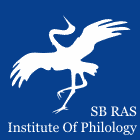 |
|
||||||||||||
|
Institute of Philology of
the Siberian Branch of Russian Academy of Sciences |
|
||||||||||||
|
|||||||||||||
DOI: 10.25205/2307-1737 Roskomnadzor certificate number Эл № ФС 77-84784 | |
| Kritika i Semiotika (Critique and Semiotics) | |
|
Article
Authors: Valerij V. Maroshi Krasnoyarsk State Pedagogical University named after V. P. Astafyev, Krasnoyarsk, Russian Federation
Abstract: The article focuses on the role of the northeast as a geographical direction in the history of the Russian frontier as well as on the symbolism of the northeast wind. These geo-poetic motifs are present in Maximilian Voloshin’s poem “Severovostok,” in V. Kaverin’s novel “Two Captains,” and in the paratext and libretto of the modern Russian musical “Nord-Ost,” which is based on the novel. The article analyzes the contexts of the northeast wind’s motif in Russian poetry of the first half of the 20th century, primarily in the works of poets from the Black Sea region and Siberia. These authors contributed to the semantics of extremity and local eschatology associated with this wind. In turn, the motifs of wind and blizzard are significant in Russian literature for the themes of Russian pioneering and for depicting the zone of contact with the infernal realm or with the wild paradise of Siberia. Keywords: Frontier, Russian literature, musical, motif, Severovostok, North-East, wind Bibliography: Bazhenova Ya. V. Smena ideologii i transformatsiya poetiki sovetskogo istoricheskogo romana (Ermak v romanakh A. Vesyologo i E. Fyodorova) [Change of ideology and transformation of the poetics of the Soviet historical novel (Yermak in the novels by A. Vesyoly and E. Fedorov)]. Vestnik Tomskogo gosudarstvennogo universiteta, 2023, no. 497, pp. 16–25. (in Russ.). DOI 10.17223/15617793/497/2 Brazhnikov I. L. Veter istorii (“Stikhiinye” metafory v poeme A. Bloka “Dvenadtsat'” [The Wind of History (“Spontaneous” metaphors in A. Blok’s poem “The Twelve”]. Vestnik Surgutskogo gosudarstvennogo pedagogicheskogo universiteta, 2011, no. 3 (14), pp. 178–183. (in Russ.) Dal V. I. Padera. In: Dal V. I. Tolkovyi slovar' zhivogo velikorusskogo yazyka. (in Russ.) URL: https://gufo.me/dict/dal/padera (accessed: 13.01.2023). Lotman M. Yu. O semiotike strakha v russkoi kul'ture [On the Semiotics of Fear in Russian Culture]. In: Semiotika strakha. Moscow, Evropa Publ., 2005, pp. 13–35. (in Russ.) Oparin P. G. Kniga M. A. Voloshina “Putyami Kaina” v literaturnom kontekste pervoi treti XX veka: istoriosofiya i poetika [M. A. Voloshin’s Book “The Ways of Cain” in the Literary Context of the First Third of the 20th Century: Historiosophy and Poetics]. Kirov, 2005, 190 p. (in Russ.) Terebikhin N. M. Severo-Vostochnyi tekst russkoi geoistoriosofii, geopoetiki i sakral'noi geografii [The North-Eastern Text of Russian Geohistoriosophy, Geopoetics, and Sacred Geography]. Vestnik Sevtrnogo (Arktichtskogo) federal'nogo universiteta. Seriya: Gumanitarnye i sotsial'nye nauki, 2023, vol. 23, no. 4, pp. 104–113. (in Russ.) DOI 10.37482/2687-1505-V274 Vyslouzhilova D. L. Severo-vostochnyi frontir Rusi: otrazhenie teorii granitsy v amerikanskoi medievistike XX v. [The Northeastern Frontier of Russia: A Reflection of the Border Theory in 20th Century American Medieval Studies]. Vestnik Udmurtskogo universiteta, 2024, vol. 34, iss. 3, pp. 642–650. (in Russ.) Yadrintsev N. M. Sibir' kak koloniya. Ee nuzhdy i potrebnosti. Ee proshloe i budushchee [Siberia as a Colony. Its Needs and Requirements. Its Past and Future]. St. Petersburg, M. M. Stasyulevich, 1882, 471 p. |
 |
Institute of Philology Nikolaeva st., 8, Novosibirsk, 630090, Russian Federation +7-383-330-15-18, ifl@philology.nsc.ru |
© Institute of Philology |


